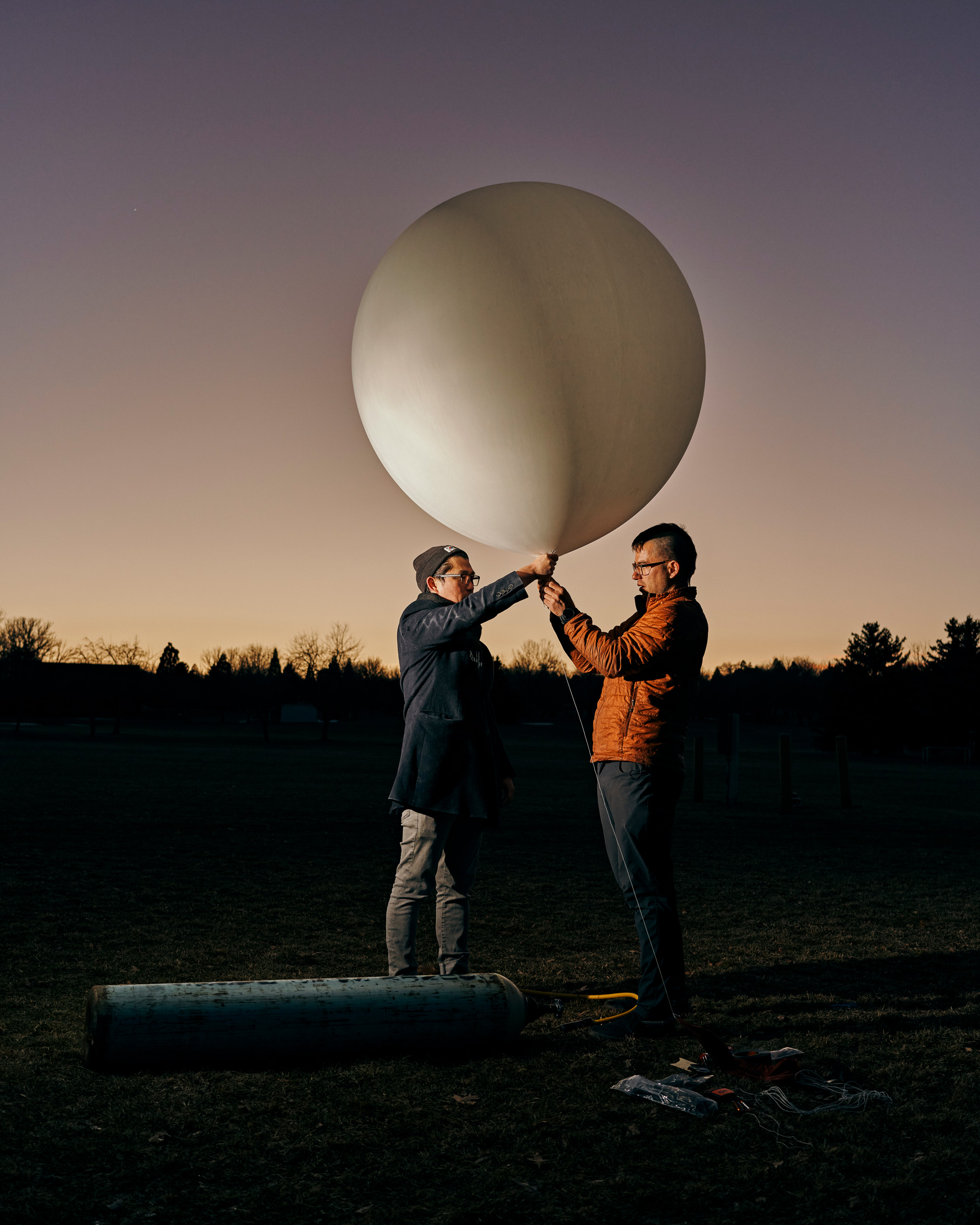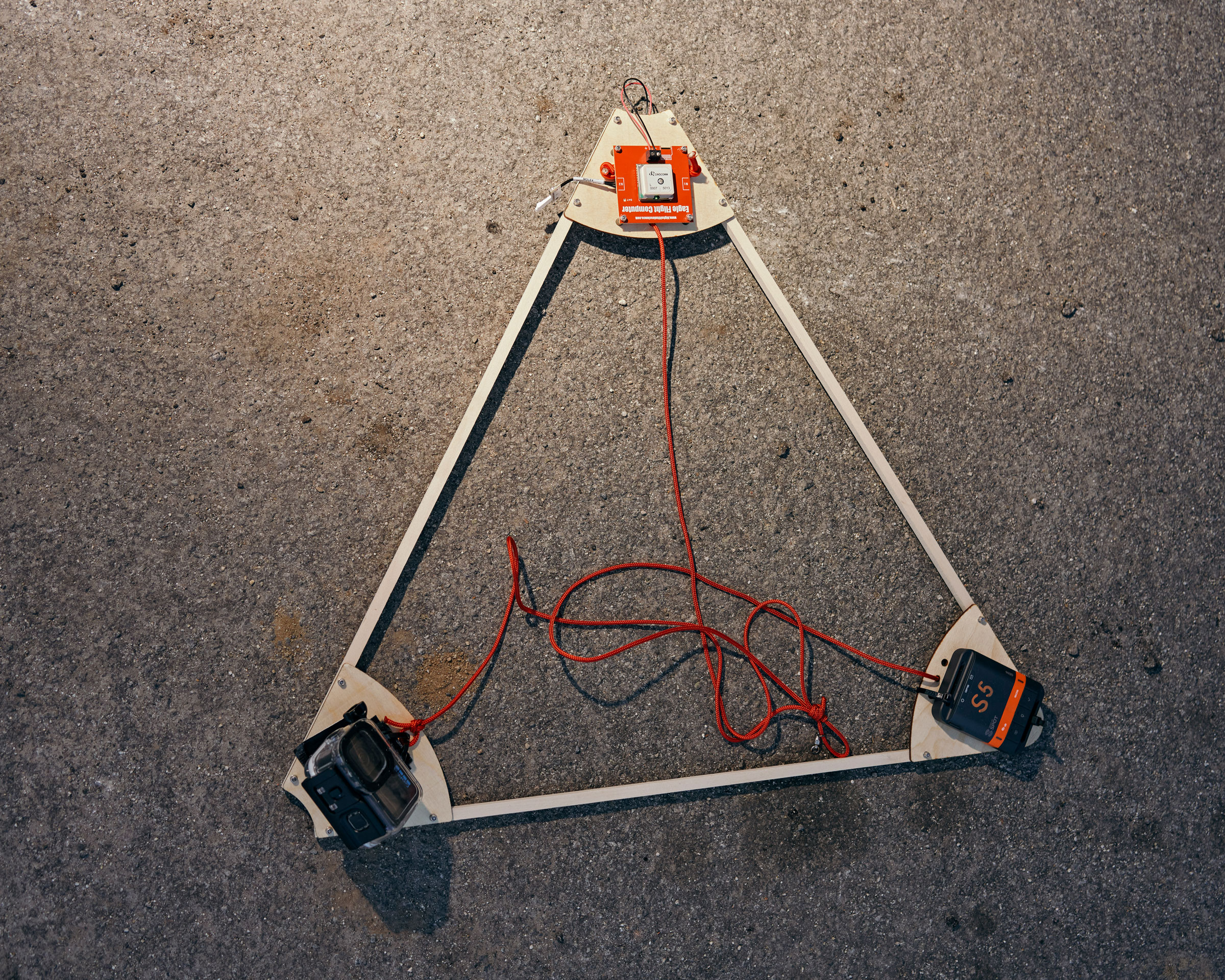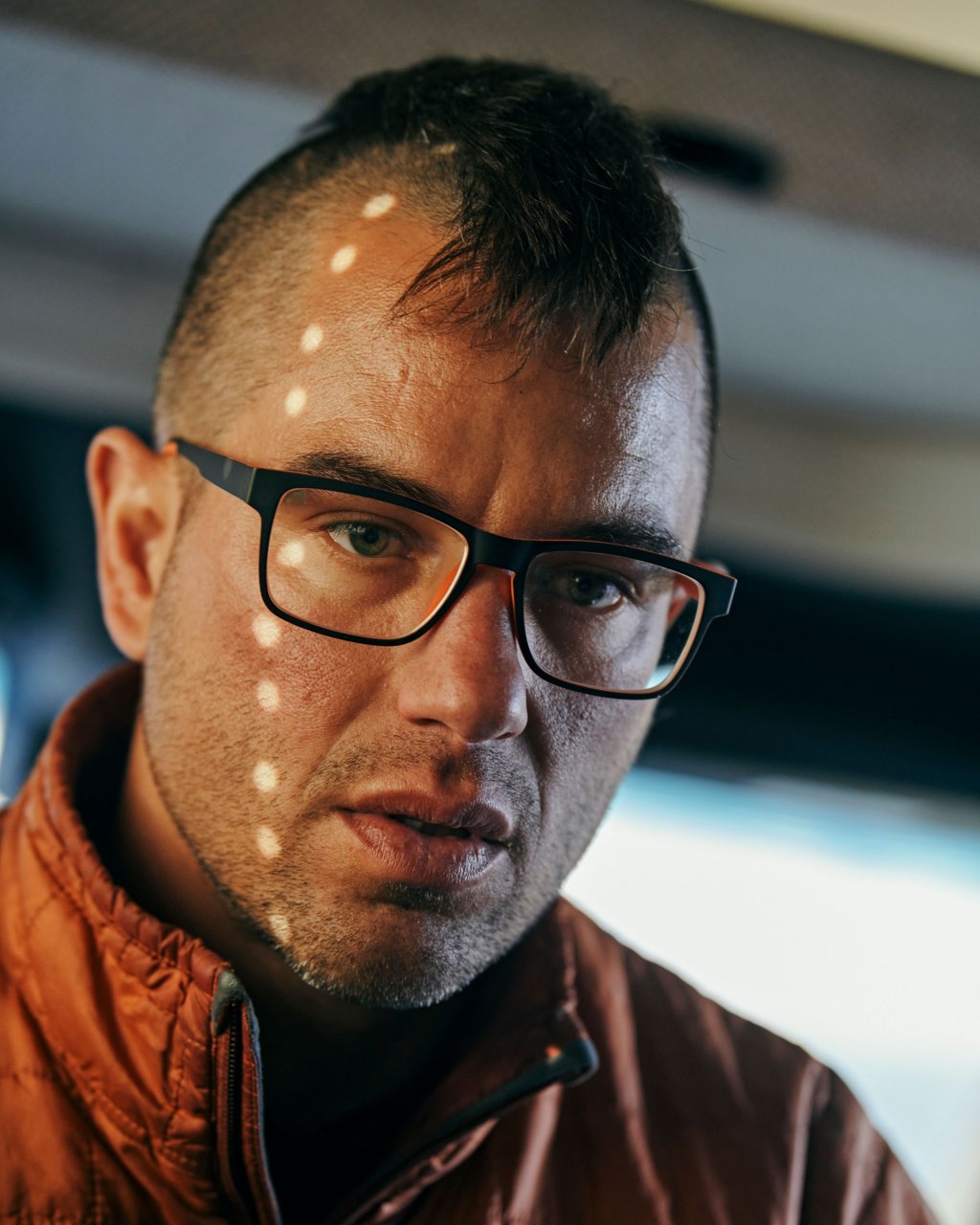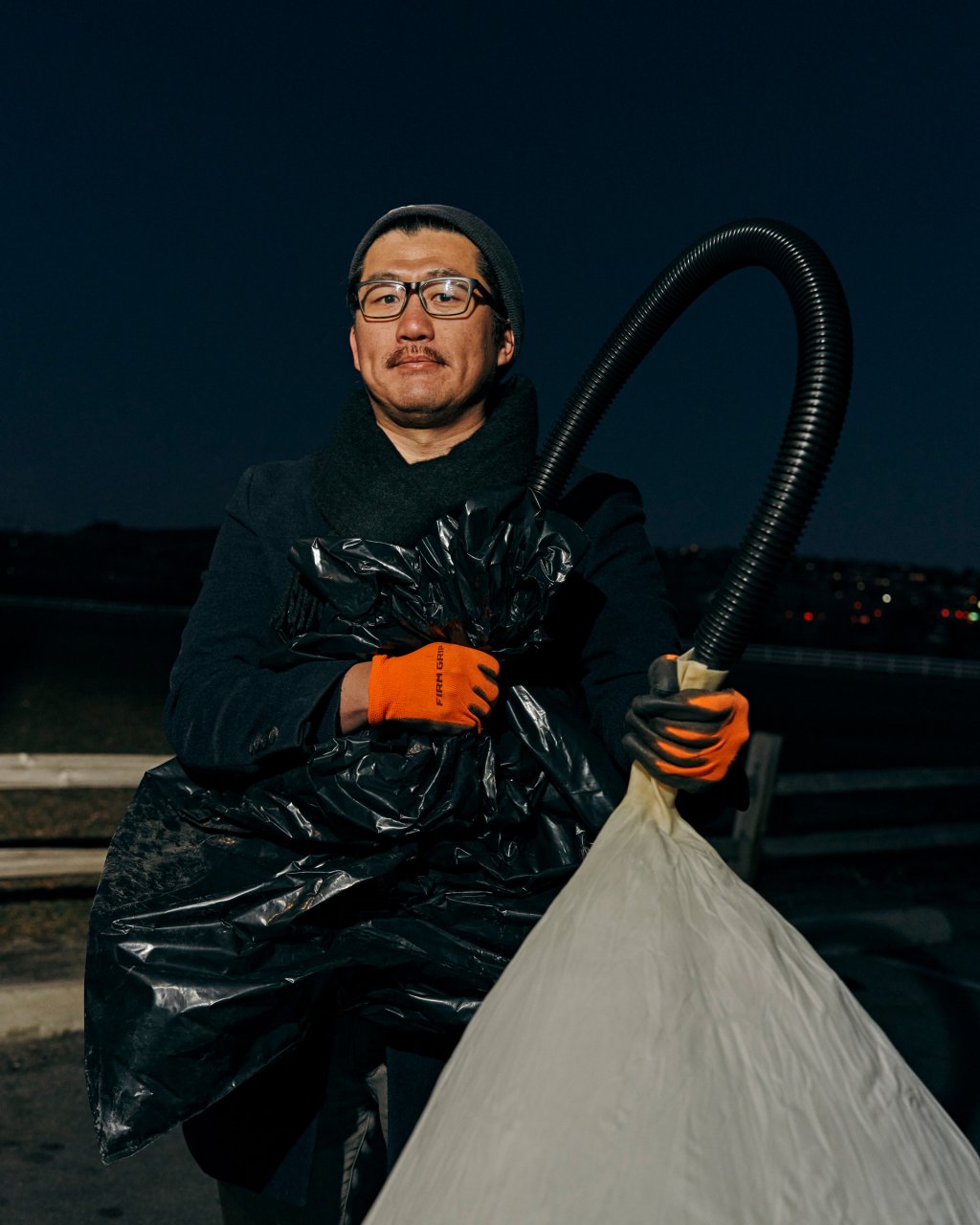
Luke Iseman, an innovator, renegade, or charlatan, depending on who you ask, but certainly the biggest climate tech trouble-maker in recent memory, is sitting cross legged on the floor of a Nevada hotel room, mohawk bent over a laptop, speaking on the phone with the Federal Aviation Administration (FAA). It’s the morning of Feb. 12, and Iseman says he’s in the last phase of dotting his i’s and crossing his t’s, legally speaking, before he releases three large weather balloons containing chemicals intended to reflect the sun’s rays back into space, the first test of the controversial climate technology in the U.S.
Such administrative preparations don’t come naturally to Iseman, 39, but things have been delicate lately. His first such balloon flights, launched from his home in Baja California, put the Mexican government in conniptions when they came to light last December—he hadn’t consulted the authorities—and resulted in officials pledging to ban any such geoengineering efforts in the country. There’s also the recent American touchiness around unidentified balloons: a ‘missiles first, questions later’ policy. And then there’s the voicemail Iseman received from the FBI Directorate on Weapons of Mass Destruction two days prior.
For now, the FAA call goes off without a hitch—they don’t ask him what the balloons are for, and Iseman doesn’t tell them. “This is going to go fucking smoothly, maybe,” he says after he hangs up. “Or everyone’s gonna say ‘Yeah, you should be fine,’ and then we launch and a fucking jet comes and shoots it down.”

Next is what Andrew Song, 37, Iseman’s mustachioed, beanied business partner, insists on calling “the cook”—as in, “We have to cook,” from meth drama Breaking Bad. The hotel room is cluttered with hardware that Iseman and Song have recently purchased from Home Depot: plastic tubing, pressure cooker, a cooler filled with dry ice, and assorted one-pound jugs of sulfur-based fungicide. There’s a towel under the door, and the window is open. Song hands me an industrial respirator when I walk in. “You’re gonna need this,” he says solemnly.
Iseman and Song intend to put a few grams of sulfur dioxide (SO2) into their helium weather balloons. In the upper atmosphere, SO2—a chemical found in airplane exhaust and ejected by volcanoes—bounces solar radiation back into space, part of the reason global temperatures can drop in the aftermath of some volcanic eruptions. Iseman and Song haven’t yet arranged for a chemicals company to supply them with SO2, so they are making it themselves. And today they’re trying out a new technique in the hotel room—a scaled-up version of something they had seen on YouTube—burning the sulfur-based fungicide, then sucking the resultant gas through tubing cooled with dry ice in order to precipitate liquid SO2 into the pressure cooker.
SO2 gas isn’t pleasant stuff. It forms sulfuric acid when it comes into contact with water, as it does in the eyes and the mucous membranes of the lungs. In sufficient concentrations, it’ll kill you. Earlier, Song had proposed burning popcorn in the hotel room to “mask the SO2 smell,” but the pair didn’t implement the idea. Iseman sits on the floor fitting tubing together with silicone tape. Song helps when Iseman asks, but otherwise stands around. He says they’re doing this indoors because the setup “doesn’t look great,” and because wind might blow away their sulfur smoke. There’s no risk of toxic exposure, though, he says—the acidity of the chemical is akin to orange juice, he claims. Iseman laughingly rejects the comparison. Song pushes on with another questionable analogy: “If you’ve ever done a massive bong hit, it’s less—a bong hit is worse than what you’re going to inhale, in terms of the pain.”
Eventually, Iseman finishes fiddling with his filtration contraption. He dons a respirator.
“Are these the acid filter ones?” he asks Song, his voice muffled.
“Yup.”
“Baller.”
Then he measures fungicide into a tin can, lights it on fire, and starts a vacuum to try to suck up the gas. My eyes burn as SO2 fills the room. Iseman becomes excited, pointing out to Song some clear droplets that have collected at the bottom of the pressure cooker. But as Song leans over, he knocks over a piece of Iseman’s setup.
“Dude, never mind,” Iseman snaps.
Then he returns his attention to the pressure cooker. “Fuck yes,” he says. “I can’t believe this is working.”

The notion of spraying chemicals in the atmosphere, known as stratospheric aerosol injection (SAI), is an old, controversial idea in climate science. For decades, a consensus held that it wasn’t worth looking into the idea seriously because the potential side effects—acid rain, damage to the ozone layer, changes to weather patterns that could cause agricultural harm—could be as bad as the problem it was meant to solve. There’s also the possibility that such research could create a moral hazard, enabling polluting nations and companies to claim that they didn’t really need to cut emissions, because we could just dose the sky with billions of tons of sulfur dioxide. Many experts maintain that position. But as the atmospheric situation has worsened in recent years, and the likelihood of the world making drastic emissions cuts in time to avert the worst effects of global warming becomes increasingly remote, some scientists have begun rehabilitating the idea of at least more thoroughly scrutinizing the potential costs and benefits. The White House is getting ready to release a five-year research plan to study the potential of different kinds of atmospheric geoengineering, including SAI, while the U.S. National Oceanic and Atmospheric Administration has been studying existing reflective particles in the stratosphere since 2020.
The idea of actually conducting real-world SAI tests, however, is still highly contentious. A small-scale test study by Harvard scientists in Scandinavia, for instance, was canceled in 2021 following outcry from environmentalists and local Indigenous groups. Then, late last year, Iseman and his innocuously-named startup Make Sunsets came along. With next to no background in atmospheric science, he had raised $750,000 from venture capital firms to commercialize SAI technology, and launched a website offering customers a chance to buy “cooling credits” for $10. In exchange for each credit, Iseman and Song pledged to inject one gram of SO2 into the upper atmosphere, which they say is equivalent to canceling out one ton of CO2 emissions for one year (CO2 hangs around in the atmosphere 1,000 times longer than SO2, so fully offsetting that same ton of CO2 would require pumping more SO2 into the sky year after year). For now, they’re using balloons and working with essentially imperceptible amounts of SO2 (a single jet airline flight, for instance, emits hundreds of times more SO2). Once they get more funding—around $20-$40 million dollars, Iseman says—they can start launching SO2 from specially equipped planes, and hope to demonstrate a small cooling effect on the world’s atmosphere. “I was like, ‘I think I’m missing something. It can’t be this easy,’” Iseman says. “Turns out it is.”
The reaction among geoscientists and climate experts has been a mixture of incredulity, mirth, and outrage. “This is one of the most egregious efforts to mislead people,” says Duncan McLaren, an environmental law and policy researcher at UCLA Law School. Experts tend to agree that the effects of SAI technology are poorly understood, and that the technology isn’t even close to being ready for commercialization—if such a thing could ever be countenanced at all. “Skeptics of solar geoengineering experimentation as well as proponents are rarely unified,” says Kevin Surprise, a lecturer on environmental studies at Mount Holyoke College. “I have not seen a single person in the field say this is a good idea.” Many are skeptical whether Iseman’s project is even doing what he claims, as his initial balloon launches didn’t have equipment to confirm that the SO2 particles were deposited in the upper atmosphere.

Song says they expected a negative reaction from the scientific community, and that it’s up to operators like him and Iseman to come into the geoengineering field and make things happen, even if they end up making a lot of mistakes. “It’s the nerds versus the jocks, maybe that’s an easy way to put it,” Song says. “I’m the jock.” Since the project came to public attention in late December, Song says he’s sold about 1,200 cooling credits to online customers. He came up with one of his most promising marketing ideas, “sunscreen for the Earth,” by asking OpenAI’s ChatGPT how he might explain geoengineering to a five-year-old.
“Stratospheric aerosol injection, that’s a fucking sketchy-sounding term, right?” he says. “No, it’s just sunscreen. Everyone understands what sunscreen is.”
A Sulfur Barbecue
At the hotel, it turns out that Iseman’s celebrations were premature—plenty of SO2 had filled the room and blown out the window, but not much had collected as a liquid in the pressure cooker. He and Song retreat to a different room to escape the corrosive gas and assemble their ballooning equipment. Towards afternoon, they pile into Song’s Winnebago and—after a stop at a local Walmart to pick up a charcoal grill—make their way to San Rafael Regional Park on the edge of the city. There, in a parking lot surrounded by dry grassy foothills and housing developments, it’s back to a tried and true method of making SO2 Iseman used in Mexico: dumping sulfur fungicide into the grill and lighting it on fire, then vacuuming the gas into garbage bags through the grill’s vent. Neither Iseman nor Song wear respirators this time. Families with children come and go as SO2 drifts across the parking lot. Song starts coughing.
“You ok?” says Iseman.
“Yeah, I got some sulfur though,” Song says. Later on, attempting to squeeze fungicide smoke from a garbage bag into a biodegradable latex balloon through a vacuum cleaner hose, Song takes another load of SO2 to the face. He starts hacking again.
“Let’s not hurt ourselves,” Iseman says, sounding frustrated.
Iseman’s affect can change quickly. He’s muscular and energetic, bounding around the parking lot with an unruly grin. He laughs when Song makes a penis joke, and seems to relish in the slapdash aspects of their venture. “So fucking amateur,” he says, almost with delight, as he attempts to copy a knot for the balloon’s parachute from his phone screen. But he also frequently becomes impatient with Song, castigating him for rushing or carelessness as they assemble the balloons. As the sun goes down and the temperature drops toward freezing, Song, wearing an impractical topcoat, says he’s getting cold. “Aww,” Iseman says with mock sympathy. “Do you want an office job?”


The pair lug a tank of helium into a field of brown grass and get ready to launch the first balloon—one of their first with equipment that can collect basic data like how high it traveled. They had weighed the balloons before and after adding the fungicide smoke—the difference, they say, is the amount of SO2 they pumped in—and now they add helium to provide lift. Such balloons expand as they climb before eventually bursting, and operators tend to carefully measure the helium they use in order to be sure their balloons reach the correct altitude. Iseman and Song appear to guestimate it. They later say the balloons contained about 10 grams of SO2 each, but they aren’t counting the flights toward fulfilling the cooling credits they’ve sold, since they couldn’t confirm they reached the correct altitude, and they don’t believe their SO2 measurements were accurate enough.
The first balloon inflates into a pale 9 ft. globe and strains upward over Iseman’s head. When he releases it, a string pulls tight and snatches his measurement equipment into the sky. Within a few seconds, the balloon shrinks to a tiny dot. Then it’s gone. The next balloon flies without trouble as well. As it’s getting dark, Iseman decides to launch one more balloon, this one without any kind of tracking hardware. Asked why, he responds, “Because I want to, basically.”
“So there’s no chance of recovering this balloon?” I ask.
“Nope,” Iseman says. “Goes up, explodes, biodegrades, saves the world.”
More from TIME
Fallout
The FBI worries turn out to be overblown—Iseman’s lawyer speaks with the agent the following morning, and apparently he only needed to be assured that Make Sunsets has nothing to do with a certain unidentified balloon they had found a few weeks earlier. But a new crisis has emerged. SilverLining, a pro-geoengineering environmental group, has gotten wind of Make Sunsets’ latest balloon flights, and put out a press release calling their cooling credits a “snake oil sales pitch” and asking U.S. authorities to stop them. Iseman is incensed. “I don’t understand,” he says as we drive west out of Reno on our way to retrieve the two balloons with tracking equipment. “They’re supposed to be advocating for this field.”
Chaos tends to follow Iseman. “He loves to create drama, or maybe like anarchy,” says his best friend Craig Cannon. There was, for instance, a memorable trip in which Iseman piled solar panels on a decrepit 20-year-old trailer and towed them across the U.S. southern border to set up an off-grid homestead, resulting in multiple stops by Mexican authorities. Iseman, who is an American, spends some of his time in London living on a houseboat, which doesn’t have a toilet, so Iseman buries the waste in public parks. For his birthdays, he invites friends to a yearly “vitality challenge,” a half marathon race with a beer for every mile. “It ends horribly,” Cannon says.
Thanks to an executive role at influential startup accelerator YCombinator from 2015 to 2016, Iseman has been blessed with occasional five-figure checks when companies he worked with get bought, and street cred in the world of venture capital. But he’s almost pathologically averse to the comfort and material excess that drive most people in the tech world. In his last VC-funded enterprise, Boxouse, he and a then-girlfriend intended to address the scourge of high Bay Area rents by creating communities of shipping container micro homes. They moved into one themselves, on an Oakland lot. “It takes some advocacy for people to realize that working 10 to 20 hours a week and having way less bills can be preferable to working 90 hours a week to live in a crappy place you don’t even like,” he said in a video recorded at the time.

The ethos, though, has sometimes left others paying for Iseman’s choices. In city emails that Iseman obtained and posted to the site of the defunct Boxouse project, neighbors around his unpermitted container community complained about late-night work noise that kept them awake, as well as a health hazard from occupants composting human waste on the site. “He drove us crazy,” says one neighbor, who asked not to be identified because she has health issues. “You look at how filthy and nasty his shipping containers were. He could have helped people, but he didn’t go about it the right way.” Ultimately, the city forced Iseman to vacate the property.
Boxouse was ostensibly a business, but it was perhaps also something of a stunt, or, more charitably, a demonstration of something Iseman believes in: that it’s possible to let go of the absurd, wasteful, environmentally destructive homes in which Americans live. Make Sunsets operates along similar lines—part business venture, part protest, intended either to spur the market for geoengineering along, or to force governments and international bodies to confront the issue themselves, or both. “I’d be super happy to end up arrested for short periods, have my company fail, and go personally bankrupt,” Iseman says. “If I could snap my fingers and spend a week in jail and give up all my money, and we have international consensus that properly geoengineers our world, great.”
But as with Boxouse, there are bystanders to Iseman’s geoengineering project who may stand in the way of his aims. In the press release announcing Mexico’s plan to ban Make Sunsets’ work, the government excoriated the Americans for failing to communicate with local communities about what they were going to do in the skies over their homes. Iseman and Song issued a contrite response on their blog. “We appreciate their concern for national and local engagement and regret that we had failed to take this into consideration sooner,” they wrote. Yet they made no apparent effort to talk to Nevadans prior to their U.S. launch, or even to warn people walking by their sulfur barbeque in the Reno-area park. (Iseman says that such engagement wasn’t necessary because he was working in a relatively unpopulated area, and because he wasn’t testing his balloons in a foreign country this time.)
To some extent, Iseman delights in the controversy his project has stirred up. He sees it as a way to garner attention for his views: that the “responsible adults” don’t have the climate situation under control, and that we urgently need to start geoengineering the atmosphere to avert deaths and irreversible ecological damage. He thinks there hasn’t been enough radical direct action on climate, that people need to start taking things into their own hands. “That I’m one of the scarier guys is pretty pathetic for the state of the world,” Iseman says. “If this is the terrifying extreme, then we’re fucked.”
Driving through the Sierra Nevada mountains, Iseman’s phone rings—it’s the Nevada governor’s office. The SilverLining press release has set off a flood of calls to state authorities, including rumors that hundreds of geoengineering balloons were being released in Nevada. Iseman explains what he had done, seeming to mollify the official. “We want enthusiastic launch partners,” Iseman tells him. “We want to work with places that want us there, and then we want to do it as responsibly as possible.”
Then, as he hangs up the phone, he laughs. The hoopla he’s stirred up seems to have already exceeded his expectations. “Is this not fucking absurd?” he says. “It almost makes it seem like I know what I’m doing. Just the amount of bang for buck from launching a couple fucking balloons.”
More Must-Reads From TIME
- The 100 Most Influential People of 2024
- The Revolution of Yulia Navalnaya
- 6 Compliments That Land Every Time
- What's the Deal With the Bitcoin Halving?
- If You're Dating Right Now , You're Brave: Column
- The AI That Could Heal a Divided Internet
- Fallout Is a Brilliant Model for the Future of Video Game Adaptations
- Want Weekly Recs on What to Watch, Read, and More? Sign Up for Worth Your Time
Write to Alejandro de la Garza at alejandro.delagarza@time.com